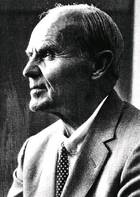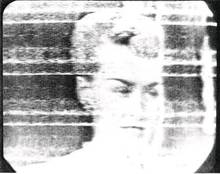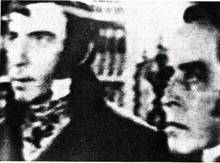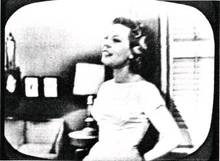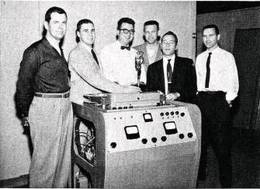In Memoriam
ALEXANDER M. PONIATOFF - 1892-1980
Dieser Artikel ist von Charles P. Ginsburg aus 1957 - erneut in 1981 zur Erinnerung und zu Ehren des verstorbenen damaligen Chefs Alexander M. Poniatoff.
Charles P. Ginsburg is vice president - advanced technology planning for Ampex Corporation's Audio-Video Systems Division. He first delivered this paper in slightly different form at the 82nd convention of the "Society of Motion Picture and Television Engineers" on October 5, 1957 - 18 months after Ampex demonstrated the first practical videotape recorder.
.
The Birth of Videotape Recording
By CHARLES P. GINSBURG
The work that led to development of the first practical videotape recorder did not flow from a divine inspiration or a miraculous breakthrough onto the road to success.
That first videotape recorder was the product of over four years of hard - and at times, inspired - work by a team of individuals who brought their own unique skills to bear on the endless problems that confronted the development team. At times, progress was slow - and twice the project was put on the shelf.
And, as it turned out, much of the real work began after we made our first successful demonstration. But that was all in the dim future back in 1951.
In October of that year 1951, after several disputes on the question of how television recording might be accomplished on magnetic tape, Alexander M. Poniatoff, founder and at that time president of Ampex Corporation, and Myron Stolaroff and Walter Selsted, his two top technical aides, agreed that a relatively small sum of money should be appropriated for the purpose of investigating a rotating head approach.The rotating head method was one which had been discussed by Stolaroff with Marvin Camras of Armour Research Foundation, of which Ampex was a licensee. The discussions engaged in by Poniatoff, Stolaroff and Selsted were concerned with the feasibility of such a system as opposed to other approaches, notably high speed techniques and time division multiplexing schemes. Accordingly, a project was authorized in December of 1951.
May of 1952
The opportunity to join Ampex to work on the project was one that I jumped to accept. Prior to the actual start of the project, the conception of the system was merely this ... three heads were to be mounted on the flat surface of a drum, scanning in arcuate fashion the surface of a 2-inch wide tape. The head-to-tape speed was to be approximately 2500 ips to allow dependable recording of 21/2 megacycle signals, and the tape was to move at 30 ips.
In its early days, the project had a relatively low priority and in May of 1952 work on the videotape recorder was suspended for three months in favor of a crash project to turn out a one-of-its-kind instrumentation recorder. It turned out to be a fortunate interruption as it put me into very close contact with a 19 year old part-time engineering student by the name of Ray M. Dolby.
Although atthattime he had had noformal engineering training, his, technical understanding and ingenuity made him k key figure in the development program from the time of his first contact with it. Dolby dropped out of school to join the project when it was resumed in August of 1952 and was rewarded by losing his student draft deferment and being inducted in March of 1953.
We demonstrated an almost unrecognizable picture in October of '52, which was promising enough to maintain management's enthusiasm. We designed and built a second system that we had running in early March of '53. In this machine we used four heads mounted on the plane face of the drum instead of three in order to make use of a two-way switching system by which the output during playback of either of the two sets of diametrically opposed heads could be selected. The radius of the arc described by the rotating heads was about 1 Va inches, which permitted approximately 105 degrees of arc to be described by each head as it swept across the 2-inch wide tape.
June of 1953
An amplitude modulation system was used in which the video signal established the limiting amplitude in a clamp modulator. The capstan motor was driven directly from 60 cycle line frequency and the high speed drum motor was driven by a power amplifier whose input was the fifth harmonic of that signal. A photocell received the reflected light impulses from a lightsource that was focused on a rotating guard ring. The 300-cycle photocell drive signal was recorded on one edge of the tape by means of a conventional stationary head. During playback, the 300-cycle signal from the tape was used as the input signal to drive and control the drum power amplifier.
Although we were rather pleased by some aspects of the reproduced picture, the pleasure was attenuated close to the vanishing point by the number of unexpected problems confronting us.The pitfalls of the discontinuous method of recording were becoming painfully obvious. The odious label 'Venetian blinds" came into being to describe certain very unpleasant flaws at the points representing the crossover from one head to the next in the reproduced picture. The unsuitability of the method of control and the necessity for extreme accuracy in the positioning of the tape relative to the rotating heads became quite apparent and a good many hours devoted to analyzing the complexity of potential errors in the arcuate sweep geometry indicated that major revisions would be in order before the rotating head VTR could be successful.
By mutual consent, the project was shelved in June of 1953 in favor of certain high priority programs then in existence at Ampex. The understanding was that the subject of videotape recording would be revived within a few months in line with proposed solutions to several of the problems. Due to the pressure of other engineering needs of the company, the review did not come about as or when agreed.
Late in September the team grows with Charles E. Anderson and others
Between June of 1953 and August of 1954 the videotape recorder had no continuous status, but a certain amount of progress had been made on specific problems by means of some very small man-hour and money allotments, some authorized and some bootlegged. Backed up by these advances, a report was submitted to management together with an urgent request for an 80-man-hour authorization to modify and demonstrate the revamped machine, which was known to us as the Mark I machine.
Receiving verbal notification that the authorization would come through, Charles E. Anderson and I changed the control system and demonstrated in August for a management committee. As a result, on September 1, 1954, the VTR program recommenced in earnest.
At the outset, there were two major technical changes. The first was a departure from arcuate sweep configuration to the geometry that became standard in the late '50s, in which the tape wrapped around the rotating drum and consequently the information was written across the tape in straight lines. The second was to be the development of an automatic gain control (AGC) system to compensate for all of the continuous as well as the step-function-type of amplitude fluctuations characteristic of the rotating head approach.
Late in September, Anderson, who was later to become the father of the FM system, Shelby Henderson, our model maker, and I were joined by Fred Pfost and in October by Alex Maxey. At the beginning of the new project, we had in our possession a total of six individual heads, four on the old drum and two spares. These heads were the first combination ferrite core and metal tip units made for video recording. They had been constructed a year and a half before, and although quite crude, they had worked at least well enough not to constitute any real limitation in the system performance during the early efforts.
Herbst 1954
Accordingly, in the Fall of 1954 we were not worried about duplicating the heads, assuming that once again some very simple jigs, some ferrite, metal tips, epoxy and elbow grease comprised the full complement of ingredients needed to duplicate them. Maxey was assigned to the task, which proved a severely aging experience for him. The problem was simply this. The new heads would not stay together under the high centrifugal force. The details of protective support holding the heads in place had been much more secure in the old configuration and we did not now have time to wait for an aging of the green epoxy. We reshaped the original composite heads in order to be abletousethem inthenewdrum. Itwasseveral months before we had the time.to go to an improved design.
In December of 1954, we made our first picture using the new geometry. The results were gratifying in terms of the improved stability, although it took a great deal of faith and understanding to be optimistic in the face of some rather gross shortcomings in the reproduced picture. The AGC system was not ready for use and it was beginning to be apparent that the problems facing it were extremely difficult.
February of 1955
Maxey had done some after-hours experimenting during February of 1955 and had discovered some very significant phenomena connected with the characteristics of pictures reproduced from tape. He found that we could definitely control the amount of information read out during playback by each of the heads per unit of arc sweep by varying the tape tension in any one of three ways: at the reels, by moving the female guide toward or away from the rotating drum, or by varying the vacuum which was pulled from the non-contact side of the tape.
Although we were concerned with the extent of the non-linearities which might be introduced by using the guide position as an information rate control, and did some experimenting with a correction method in which the amount of vacuum was varied, we subsequently discovered that the non-linearity in the first method was quite unobjectionable. This technique of varying the tape tension proved to be one of the major breakthroughs in the program.
It provided an excellent solution for the problem of information rate changing as the heads wore down to a smaller sweep radius, and it gave an answer to a part of the question of ultimate interchangability of recorded tapes from one machine to another.
We made a radical change in the design of the individual magnetic heads, going to a sandwich-type of construction that provided the necessary mechanical support and which was also far more reproducible. A good deal of work was done during this period in a much more quantitative fashion than we ever had time to do before on the magnetic characteristics and performance of the heads.
A very convincing demonstration
On March 2, 1955, we gave a very convincing demonstration for the board of directors. The resolution was extremely low as the system was somewhat less than 1 1/2 megacycles wide. The monitor had to be operated with a short time constant in the horizontal AFC because of velocity variations in the head drum, which was at that time belt-driven.
The month that followed was one of careful deliberation on many questions, all of which had to be answered with reasonable accuracy in order to be able to steer the proper course from promising results to payoff.
It seemed that we had come a long way in a short time using a broadside attack on many of the problems. The approach would certainly have to become more refined before we could be sure of our ground in turning out a commercially acceptable product. Rather than give a full account of what we then knew we didn't know, let alone what we didn't know we didn't know, I shall say only that we proceeded under a new engineering project authorization that contained lots of caution but which did have as its objective a system suitable for public demonstration within one year.
Philip L. Gundy, then general manager of the Audio Division, of which we were a part, made a major contribution to the program at this time by moving us to isolated quarters with five times as much space as we had before. Now truly behind closed doors, we went to work.
December 1955
In late December 1955 Anderson, possibly daunted by AGC troubles, proposed (for the second time, he later claimed) using a vestigial sideband FM system rather than the old amplitude modulation. Some technical support to his belief that the new method would work was furnished by results the FCC had obtained a few years earlier in conjunction with tests on vestigial sideband FM transmission of television signals. The big questions for us centered around the very unusual relations among carrier, deviation, and modulating frequencies. Anderson began work on the new system January 2,1955 and early in February we saw our first FM picture off tape.
Meanwhile, Ray Dolby, who had finished his tour of military service and had returned to Ampex on a part-time basis while continuing a full college program, had started on a simplified FM method. Whereas Anderson had used fairly conventional reactance-tube techniques, heterodyning the sidebands from the 50 megacycle region down to frequencies suitable for reproduction from tape, and subsequently moving the information on playback up to about 50 megacycles for transmission through high frequency IF amplifiers and limiter circuits, Dolby designed and built a multivibrator which could be modulated by applying the composite video signal directly to the control grids.
Since the free-running frequency of the multivibrator could be set to a value suitable for transmission by heads and tape, circuit complexity and development time were greatly reduced. The pictures obtained with the multivibrator modulator on February 25 were even better than those with the reactance tube system earlier in the month.
Pfost and the new head development program
The entire new head development program was carried by Pfost, wrio exhibited unbelievable tenacity and patience in coping with the all-important microcosms. Anyone who has attempted to wrest adequate response from magnetic heads at wavelengths below 200 microinches is well aware of the problems that were faced.
The modulation system was extended in bandwidth so that it would be suitable to operate with a carrier frequency of as high as six megacycles if such an operating frequency should subsequently turn out to be usable. The switching unit, which had previously been a two-mode device, was replaced by a four-way switcher that would allow only one channel at a time to conduct.
We made considerable improvements in resolution and in signal-to-noise ratio. We stabilized the drum sufficiently to allow the display of pictures from tape on a standard monitor. We had been making no attempt during this period to design a dressed up machine and had merely built a rather crude looking wooden cabinet containing the top plate and a few electronic units which operated in conjunction with two partially full racks. At a very small showing that we gave for some officers of the firm toward the end of 1955, it was suggested that we should package more attractively what was going to be a very expensive machine.
February of 1956 + NAB convention in Chicago in April 1956
Accordingly, Anderson designed the Mark IV console with its compact rack arrangement. It was also decided at this time that we should start thinking definitely in terms of a surprise demonstration at the "National Association of Radio and Television Broadcasters" (NARTB - später nur NAB) convention in Chicago in April of 1956.
In early February of 1956, we gave a demonstration for what was originally supposed to be a very small management group but turned out to be one attended by about 30 Ampex people. For all of us on the engineering project, this was the most dramatic demonstration we were to make.
The guests arrived, were seated, a few words were spoken to the effect that we would show them what we had produced, and the machine was then put in the playback mode and played back a program we had recorded an hour earlier.
We then announced that we would record a sequence and immediately play it back. We recorded for about two minutes, rewound and stopped the tape, and pushed the playback button. Completely silent up to this point, the entire group rose to its feet and shook the building with hand-clapping and shouting. The two engineers who had done more fighting between themselves than the rest of the engineering crew combined, shook hands and slapped each other on the back with tears streaming down their faces.
We had quite a few visitors during the next couple of weeks, including Bill Lodge of CBS, Frank Marx of ABC and representatives of the CBC and BBC. The visitors were all sworn to absolute secrecy and generally ushered in and out separately so that they would not see each other.
As a result of Lodge's visit, arrangements were made to use a demonstration model, the Mark IV machine, which had not yet been assembled, for a surprise showing to the annual CBS affiliates meeting that was to occur the day before the formal opening of the NARTB convention.
With about six weeks to go before the convention, working hours were extended considerably in order to complete the construction of the Mark IV unit and at the same time to continue development work so that the picture to be demonstrated in Chicago would be as good as CBS was expecting it to be. The activity became furious.
The administrative engineer for the now considerably enlarged group shed his business suit in favor of work shirt and jeans and spent most of his regular time plus nights and weekends modifying mounting brackets for the new Mark IV console, making cable assemblies, and building up redesigned electronic units.
A three year old idea of placing the switching transients in the horizontal blanking interval was rushed into hardware form as the blanking switcher and integrated into the basic system as a toggle switch option. An automatic rotary head degaussing system came into being to obviate the necessity of manually demagnetizing the video heads after a recording operation and prior to playback.
The Mark III for Redwood City and the Matk IV for Chicago
Meanwhile, it had been decided that Mark III, the machine used for the prior demonstrations in February, should be used for a press demonstration in Redwood City, California, on the same day that the NARTB showing was to start.
Therefore, while Mark III was being used for development work, barely leading the construction of Mark IV, it also had to be prepared for its press appearance. The true orphan of the project, the audio, which had been sadly neglected uptothis point, had to be made at least to approach professional standards.
There were many heroes during this period, but leading them all was Pfost. Fred experimented with the heads up to the morning before embarking for Chicago. He varied tip structure, core structure, core windings, gap spacing, guide setting, current setting and built new heads continuously.
He did an unbelievable amount of work during this period. In the last four weeks preceding the Chicago demonstration, Pfost put in an average of well over 100 hours per week.
At last Mark IV was broken down into many pieces and shipped to Chicago. Three days before the press demonstration, the Redwood City machine was in severe mechanical trouble. Those of us who were headed for Chicago took off, wishing the stay-at-homes good luck and trying notto think about their difficulties.
The demonstrations were a bomb shell in the industry.
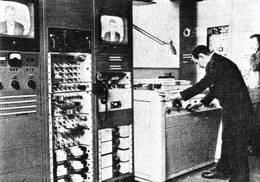
- The historic first broadcast via tape was CBS' November 30, 1956 airing of the "Douglas Edwards and the News" program from New York City. CBS Television City in Hollywood, pictured above, replayed the broadcast three hours later on the West Coast and in the months following, the other networks were to follow CBS' lead.
The demonstrations were scheduled for Saturday. By Thursday afternoon, Mark IV was assembled in Chicago and was making the best pictures we had ever seen from tape. A predictable situation then occurred. The CBS engineering staff said the pictures were not good enough. The signal-to-noise ratio was too low and the noise banding was intolerable.
Between Thursday night and Friday night, we made it. By dint of cutting, trimming and adjusting and aided by the last minute delivery of some tape samples that greatly exceeded in performance anything we had seen before, everyone was satisfied. Checking with the crew in Redwood City, we found that they had solved their mechanical problems and they were now ready for the demonstration.
The demonstrations were a bomb shell in the industry. In Redwood City the performance was sensational, exciting and satisfying. In Chicago, pandemonium broke loose and Ampex was flooded with orders.
From the time of the CBS affiliates meeting on Saturday morning, through the demonstrations extending until the following Thursday afternoon for the convention delegates in general, the machine performed better than we had any right to expect.
The next several months were just hard work. Four months earlier Ampex had expected to deliver five prototype machines beginning in the late Summer or early Fall to customers in government agencies for evaluation, along with a gradual program leading to delivery of machines for TV use starting in 1957. Now we were faced with the pressure of making 16 hand-built machines, most of them going to broadcasters for immediate on-the-air use, and at the same time we had to gear up for full-scale production of units the industry was eager to put to work.
Our problem was the head life of about 100 hours
In spite of the subjectively good pictures demonstrated in April of 1956, a resume of the tasks that had to be covered before releasing the first machine for air use (auf Sendung gehen) reveals how shaky our ground actually was at the time.
Until then, neither manpower nor machine facilities nor technical advances were sufficient to properly evaluate magnetic tape for videotape recording use. And until we could rate the tape manufacturers' samples with comments much more informative than "fair output," "too many dropouts," or "doesn't wear well," there was not too much that could be accomplished toward getting really satisfactory tape.
The tape evaluation program consumed many hundreds of man hours and was the cause of severe headaches to the tape manufacturers, to us and to our early network customers. With a then-predicted head life of 100 hours, we could not continue to make heads in a tedious one-at-a-time fashion.
The many parameters in head construction, several of which had been varied madly in cut-and-try fashion in order to squeeze out a few more precious db of signal-to-noise ratio for the April 1956 demonstrations, had to be settled on and frozen in order to establish at least our own standards before the delivery of the first machines.
.
From handcrafting technique to semiproduction process
At the same time, head construction had to evolve into a semiproduction process rather than a handcrafting technique. A processing unit had to be designed and developed which would be capable of providing blanking and sync in the reproduce signal that were sufficiently free of noise to allow the signal to be handled without difficulty by conventional stabilizing amplifiers and clamps anywhere along the line of transmission.
The picture reproduced from tape had to be greatly improved over that shown in April with respect to noise, resolution, overshoot and ringing, and horizontal stability. The entire machine and all individual chassis had to be repackaged and tested.
The mechanical design details were endless. Our top plate components had to be not only reliable but completely interchangeable. And always the struggle for greater bandwidth and better signal-to-noise ratio.
John King, Roger Hibbard and Tony Severdia
More hero medals in October and November 1956 went to John King, Roger Hibbard and Tony Severdia, who several times started a work day at 8 in the morning and finished it 30 hours later.
The videotape recorder went on the air for the first time on November 30, 1956, from the CBS Television City in Los Angeles. NBC followed suit at the very beginning of 1957, and ABC started delayed telecasts from tape at the beginning of daylight savings time in April 1957.
From that beginning, videotape recording grew into a billion dollar industry that touches our lives in some way every day.
None of that would have happened without the participation of many others:
- • The television broadcast industry, which wholeheartedly accepted the product of our labors;
- • Our prototype customers, the networks, which provided technical assistance, patience and tolerance during the trying days of early on-the-air use;
- • The magnetic tape manufacturers, who successfully developed a product suitable for television.
And, of course, my colleagues - the wonderful people who lived and breathed videotape recording until it became a reality.
© 1981 Ampex Corporation Litho in USA-3/81-V-719
.

